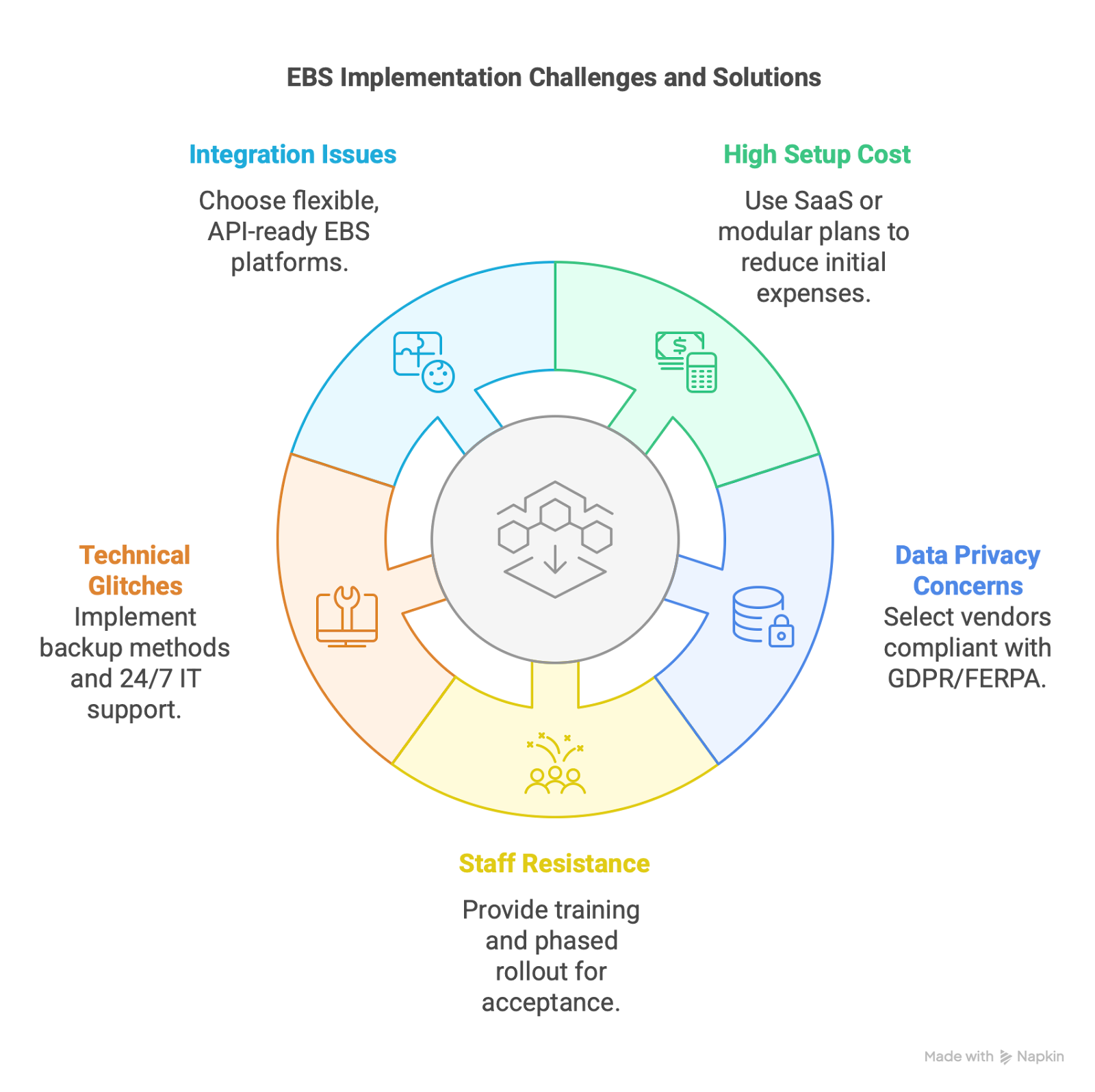Educational institutions are increasingly using innovative solutions to streamline operations and enhance productivity. The Enterprise Business System (EBS) is one of the most crucial instruments in modern campus administration. One of the significant applications of EBS has, however, turned out to be a game-changer in campus management: automating attendance through EBS systems.
This blog explores how EBS systems are changing the face of attendance tracking in the world’s schools, colleges, and universities, presenting a complete keyword-optimized account of the features, benefits, challenges, and future of automated attendance systems.
What is an EBS System?
An Enterprise Business System (EBS) is a comprehensive software suite that integrates key functions across an institution’s departments.EBS programs integrate processes from admission and finance through academic management and student services, letting departments work more smoothly and having a single interface for all stakeholders.
Why Automating Attendance is Crucial
Manual attendance tracking is outdated, time-consuming, and error-prone. In contrast, automated attendance systems powered by EBS offer real-time tracking, eliminate manual errors, and improve accountability. Automating this essential process is no longer a luxury—it’s a necessity for educational institutions seeking to modernize and scale.
Benefits of Automating Attendance with EBS Systems
1. Real-Time Attendance Tracking
Automated attendance systems integrated with EBS allow for real-time attendance monitoring. Using RFID cards, biometric scanners, or facial recognition technology, students’ attendance is recorded instantly upon entering the classroom.
Key Advantages:
- Instant data capture
- Reduced time spent on manual roll calls
- Accurate and up-to-date records
2. Centralized Attendance Management
All attendance data is stored in a centralized EBS database, making it accessible to faculty, students, and administrative staff. This ensures consistency across departments and courses.
Centralized Features:
- Uniform attendance policies
- Single dashboard for reporting and analytics
- Easy integration with academic performance records
3. Reduced Administrative Burden
By automating attendance, administrative staff no longer need to manually update or audit attendance sheets. This frees up time for more strategic and value-driven tasks.
Time-Saving Outcomes:
- Fewer manual processes
- Reduced paperwork
- Lower operational costs
4. Improved Student Accountability
Students can access their own attendance records through student portals or mobile apps connected to the EBS. This transparency encourages responsibility and punctuality.
Engagement Benefits:
- Increased class attendance
- Timely alerts for low attendance
- Greater student awareness
5. Seamless Integration with Other Systems
EBS-based attendance systems integrate effortlessly with other campus modules such as learning management systems (LMS), grading systems, and HR tools for faculty attendance.
Integration Perks:
- Sync with academic calendars
- Auto-notification of absences
- Link to performance tracking
Technologies Powering EBS Attendance Systems
1. RFID (Radio Frequency Identification)
RFID cards enable quick and contactless attendance marking. Students simply swipe or scan their ID cards at the classroom entrance.
2. Biometric Authentication
Fingerprint and facial recognition systems ensure that only the registered student can mark attendance, reducing proxy entries and improving data integrity.
3. Mobile App Integration
EBS platforms often offer mobile apps that allow students to check attendance, receive alerts, and submit leave requests. Faculty can monitor attendance from anywhere.
4. Cloud-Based Systems
Cloud integration ensures data is accessible, secure, and scalable. This is especially useful for institutions with multiple campuses.
How EBS Systems Enhance Campus Management
1. Data-Driven Decision Making
EBS systems generate detailed reports and analytics that help administrators and faculty identify trends, at-risk students, and overall engagement levels.
2. Policy Enforcement
Automated systems enforce attendance policies uniformly across departments, eliminating favoritism or errors in compliance.
3. Boosted Operational Efficiency
Campus operations become faster and more reliable. From scheduling and resource allocation to disciplinary actions, attendance data feeds into every aspect of administration.
4. Improved Parent and Guardian Communication
Some EBS platforms include parent portals where guardians can track their child’s attendance and receive real-time updates.
Real-World Use Cases
1. Universities
Large universities like the University of California system and IITs in India have adopted EBS platforms such as Oracle PeopleSoft or Ellucian Banner to manage operations. Automated attendance solutions integrated into these systems help faculty track student engagement and support academic advising by providing analytics on participation trends.
2. Colleges
Institutes like the Indian School of Business (ISB) or community colleges in the U.S. use EBS tools to link attendance with student performance and placement readiness. For example, ISB integrates attendance tracking into its academic dashboards, helping placement cells identify high-performing, consistent attendees for recruiter profiles.
3. K-12 Schools
Schools such as The Shri Ram School in India or charter school networks like KIPP in the U.S. utilize EBS platforms with tablet-based attendance apps. These tools allow teachers to mark attendance quickly and notify parents instantly through integrated communication portals, improving transparency and response time for absenteeism.
VAPS Digital Campus NEP Platform offers customisable attendance modules integrated with EBS systems. These solutions include biometric and facial recognition attendance, analytics dashboards, and mobile interfaces under a unified platform. Institutions can tailor workflows and integrate attendance data directly into their ERP dashboards to streamline processes and enhance reporting.
Challenges in Implementing EBS Attendance Systems
1. High Initial Investment
Installing biometric scanners or RFID readers across campus can be expensive. However, the long-term ROI justifies the upfront costs.
2. Data Privacy Concerns
Biometric data and student records are sensitive. Institutions must ensure data encryption, secure access, and compliance with local data protection regulations.
3. Resistance to Change
Teachers and staff may resist new technology. Proper training and phased implementation are essential to overcome these barriers.
4. Technical Downtime
Any system can face outages. Institutions need backup attendance methods and robust IT support to minimize disruption.
Best Practices for Deploying EBS-Based Attendance Systems
1. Choose Scalable Solutions
Pick an EBS system that can grow with your institution’s needs and integrate with future technologies.
2. Provide Training and Support
Offer comprehensive training sessions for faculty and staff to ensure smooth adoption.
3. Ensure Compliance and Security
Partner with vendors that prioritize data privacy and meet compliance standards like FERPA or GDPR.
4. Gather Feedback and Iterate
Encourage feedback from users to continually refine the system and address pain points.
The Future of Attendance Management with EBS
As educational institutions evolve, EBS systems will continue to play a pivotal role in shaping digital campuses. Future trends include:
1. AI-Powered Attendance Analytics
Artificial Intelligence will predict student behavior, enabling proactive interventions for absenteeism and poor performance.
2. IoT Integration
Smart classrooms with IoT devices will allow automated check-ins based on student presence detected via wearable tech or smartphones.
3. Hybrid Learning Compatibility
With the rise of online and hybrid learning models, EBS platforms will enable attendance tracking for both in-person and remote sessions.
A Smart Move Toward Smart Campuses
Automating attendance through EBS systems is not just about saving time—it’s about transforming how institutions operate. From real-time data capture to advanced analytics and seamless integrations, EBS platforms offer a holistic approach to campus management.
By adopting EBS-powered attendance systems, educational institutions can enhance student engagement, reduce administrative load, and make data-driven decisions that contribute to academic success and institutional growth.
Ready to make your campus smarter? Embrace EBS systems and lead the way in modern education management.












